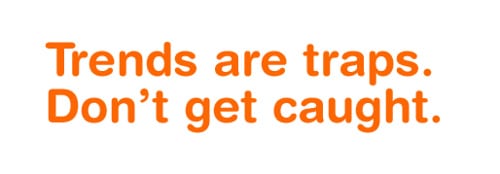On-trend. It’s a word you hear in marketing lingo and often in advertisements. “This look is on-trend!” You’ll also hear and read the more insidious “Make sure that you’re on-trend!” Trends, obviously, are an important part of the health and beauty, fashion, home décor and even home building industries. In fact, there is probably an entire list of industries that rely on trends to generate profits and marketing that we didn’t just mention. But have you ever thought of where trends originate or how marketers use them? Yes, it’s true that some trends are created by marketers to get you to buy things. And some trends begin as organic movements and then get co-opted by marketers. Either way, the latest trend, at the end of the day, is a tool to get you to buy more “stuff.” Today, we’re exploring the reality of trends.
The Marketing Created Trend: Look to Designers and Developers
Imagine what the staff meeting looks like at, say for example, a design house that releases fashion each year or a makeup company. They know that the industry is divided into seasons and that each season has a look. While they certainly care about designing beautiful and wonderful products, the truth of the matter is that they also are talking about how they need to give you something “new” or “fresh” to desire and buy. How do they create a trend around their product or design so that you will feel like the version that you have isn’t good enough and buy a new one? What can they make “hot” and how can they use PR and editorial advertising to make you think it’s hot? It’s not entirely dissimilar to how electronics companies create a constant stream of upgrades in order to keep you buying. Much of the thinking is the same. You want to feel like a part of the hip crowd, so you need the latest trends. If the company or design house controls those trends, then they have a jump on convincing you to purchase. But what are these trends, really? As we just showed, they are nothing more than constructs created in a marketing bubble. And you don’t need them. And they don’t define you. But we’ll talk about that later!
The Marketing Co-Opted Trend: What Once Defined Rebellion …
Of course, not all trends are manufactured. Many of them grow organically in groups of people and subcultures. Ironically, many of these organic trends begin as a rebellion against institutionalized fashion and styles. The “hipster trend” is a great example of that. Hipster styles began because entire generations of youth were shopping at thrift stores and buying vintage and used pieces as a protest against the high prices, questionable labor practices and eco-standards of institutionalized clothing and fashion. However, over time, manufacturers and retailers identified the trend as an opportunity to cash in. Before long, the same styles and fits that hipsters were wearing because they were available in thrift stores were on the racks in department and even high-end stores for hundreds of dollars. And naturally people were buying them! Another example that some might be more familiar with is the punk rock fashion trend. It’s typically not design houses that co-opt these trends but rather big box retailers or department stores wanting to entice “youth sales.” Of course, we can all bemoan the fact that rebellions eventually turn into trends, but that’s also very much the natural cycle of marketing that will almost always without fail happen.
How Do You Combat Trend Marketing?
We love to use the phrase “be your own brand” when it comes to combatting trend-based marketing. After all, brands in general are the actual stamp of consumerism on our society. We actually also think that you’ll be happier when you find an individual style that speaks to you as opposed to one dictated by marketers in offices. What is that style? That’s a journey for you to undergo, and we think it may be a fun one that, along the way, will help you build confidence.
We also often suggest that it’s always a great idea to stick to classic styles instead of trends. While we’re suggesting it so that you won’t be at the mercy of marketers and marketing, anybody who grew up in the eighties also knows the risk of buying into trends! We know a lot of people who wish that they could get rid of pictures of themselves in shoulder pads and huge hair!
Where You Fall on the Trend Spectrum Is Entirely Your Choice
Of course, we’re not here to tell you how to dress or what to purchase. We’re simply here to provide educational material and make sure that you’re aware of the gears in the consumer marketing machine that may or may not be influencing you. Whether wearing or using on-trend styles and merchandise is important to you is entirely a personal decision. Every individual needs to find his or her own comfort zone on the postconsumer spectrum of how much is enough for today. That includes you. We just want you to do it with awareness!
Trends will always be around and developing, and many of them are fantastic counter-culture movements that create important turns and twists in society. The word “trend” isn’t a dirty thing. But allowing it to be used as a tool to strongly lead you into consumer purchases is a choice that you can stop making now that you have the power behind it!
Did we miss a way that trends drive the consumer machine? Tell us about it on the social media channels below.
Facebook | Twitter | Instagram | Tumblr | Pinterest | Google+ | Medium
Photo Credit: Marie-Chantale Turgeon via Flickr





